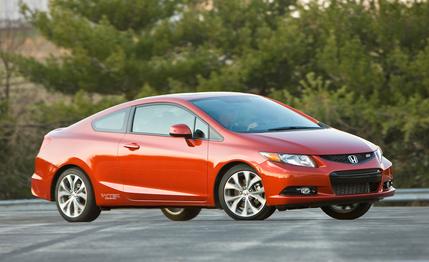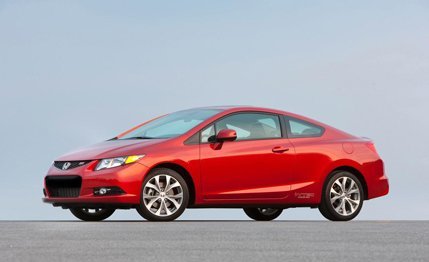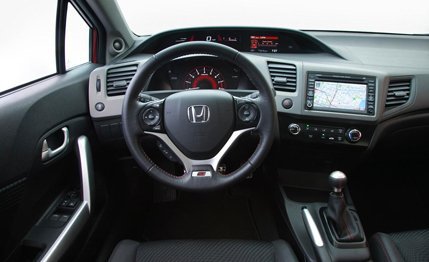 First Drive Review
First Drive Review
Read our first drive of the 2012 Civic sedan and coupe here
“People have been saying that Honda has lost its mojo, but that’s not true. We just put it in a closet for a while.” That pronouncement comes from a Honda insider, delivered in a whisper and on condition of anonymity. After all, with the demise of the S2000 sports car, the Si is the only four-wheeled Honda with any performance cred. But if you’ve been waiting for a significant uptick in Si mojo—enough to put it a little closer to the pace of the Mazdaspeed 3 or VW GTI—we hope you aren’t holding your breath.

Specifically Speaking
Let’s look at some numbers. The outgoing Si was motivated by a 2.0-liter, naturally aspirated aluminum four with Honda’s clever i-VTEC DOHC system creating impressive top end power: 197 horses at 7800 rpm. It was typical of a generation of Honda engines that extracted serious output from small displacement, with the same 86-mm bore and stroke, lots of revs (8000-rpm redline), a little thirsty when pressed hard, and distinctly short on torque, but rewarding to the driver who valued a taste of racing technology in an affordable street car.
The new Si marches to a different beat, the 2.0 replaced by a 2.4-liter i-VTEC four with a distinctly long-stroke design—87-mm bore and 99-mm stroke—that doesn’t quite provide the high-rpm rush of its predecessor. Redline (and power peak) are listed at 7000 rpm, which is odd, but there’s a smidge more top end—201 hp—and a notably fatter midrange. Displacement is the wellspring of torque, particularly in a naturally aspirated engine, and there’s more of it here than in the old engine: 170 lb-ft at 4400 rpm versus 139 at 6100. You can expect more of this long-stroke approach in the future as carmakers work to reduce fuel consumption and emissions.
A slick six-speed manual continues to be the only transmission—we’ve no complaints on that point—and EPA fuel-economy forecasts are unchanged: 22 mpg city/31 highway, with a strict diet of premium fuel still required.
The Package

The sheetmetal surrounding the Si’s new engine will look familiar to the Civic faithful. There are fresh creases and new tweaks, but Honda chose to carry on with essentially the same slippery shape it introduced in 2005. “Same” doesn’t mean carbon copy, however. Although most body dimensions are pretty much identical, the wheelbase has been shortened by 1.1 inches for the coupe.
Given Honda’s emphasis on smooth ride quality, even in the Si, the shorter wheelbase might seem surprising. But the redesign includes increased chassis rigidity—a 10-percent uptick in static rigidity, 12-percent in dynamic, according to the engineering team—meaning more latitude for suspension tuning. As before, the Si models get higher spring rates, harder suspension bushings, and firmer damping than lesser Civics. Honda also preserved the previous generation’s limited-slip diff and electric power steering.
The Sum of the Parts
Does all of this add up to a better Civic Si? As our drive was confined to limited seat time on urban streets devoid of challenge—plus one run on a stadium-parking-lot autocross course—the jury is out. Grip seems adequate—the 17-inch wheel-and-tire package (215/45s) is unchanged—and an increase in front rotor size should produce improved braking, something the previous Si needed. The intervention threshold of the stability-control system is high; weekend autocross warriors could well run competitive times without turning it off. Honda’s work with ride quality seems to have produced the desired result—if creamy ride quality is a key objective in a car such as this. However, the “motion-adaptive electric power-assisted rack-and-pinion steering” is light, vague, and at 3.1 turns lock-to-lock, a little slow for a car in this class.

On the power side of the equation, the new Si’s around-town response seems a little more vigorous, delivering more thrust at lower rpm. And although we miss the high-rpm scream of the 2.0, the 2.4-liter’s exhaust note has an authoritative tenor snarl. The question remains, however, whether the Si’s tiny hp increase would put it any closer to its hot-hatch rivals from Mazda and VW in a straight line. And we have yet to experience the hot ST version of the new Ford Focus.
Pricing Strategy
Pricing for the 2012 Civic Si coupe starts at $22,955 (the sedan opens at $23,155). The only stand-alone option is high-performance summer tires (add $200). Nav and satellite radio are baked into a $1500 package. That puts a loaded Civic Si right where pricing begins for the Mazdaspeed 3 or Volkswagen GTI.
So the new Si appears to be strategically positioned against the top dogs in this class. The quality of the interior materials has improved, the front buckets provide a more lateral support—with no sacrifice in comfort—and the red accents and stitchery provide a sporty note without looking juvenile. Based on our limited exposure, the latest Si looks as though it should at least be satisfying to just about anyone. On the other hand, if you—like us—had hoped for the sort of mojo that distinguished the last generation, you might be a bit underwhelmed.